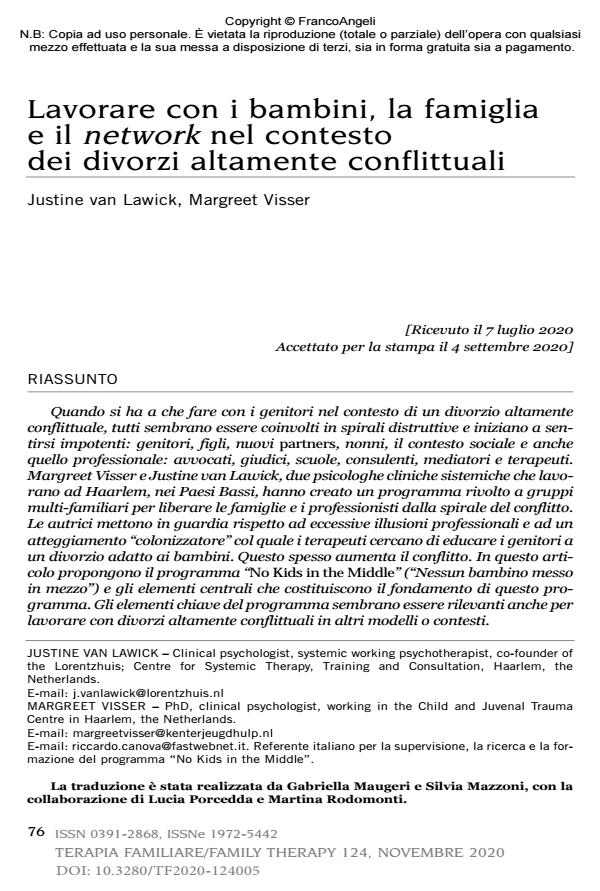Working with children, family and network in the context of high conflict divorce
Journal title TERAPIA FAMILIARE
Author/s Justine van Lawick, Margreet Visser
Publishing Year 2021 Issue 2020/124 Language Italian
Pages 23 P. 76-98 File size 128 KB
DOI 10.3280/TF2020-124005
DOI is like a bar code for intellectual property: to have more infomation
click here
Below, you can see the article first page
If you want to buy this article in PDF format, you can do it, following the instructions to buy download credits

FrancoAngeli is member of Publishers International Linking Association, Inc (PILA), a not-for-profit association which run the CrossRef service enabling links to and from online scholarly content.
With divorced parents in high conflict everybody seems to get caught in the destructive spirals and starts to feel powerless: parents, children, new partners, grandparents, the social network, and also the professional network: lawyers, judges, schools, counsellors, mediators and therapists. Margreet Visser and Justine van Lawick, two systemic working clinical psychologists in Haarlem, the Netherlands, created a multi-family group program to free the families and professionals from the conflict spirals. They warn for too much professional illusions and a colonising attitude in which the therapists try to educate the parents about a good and child friendly divorce. That often increases the struggle. In this article they propose the No kids in the Middle program and the keystones that form the fundament of this program. The keystones seem also to be relevant for working with high conflict divorces in other formats or contexts.
Keywords: High conflict divorce, therapeutic illusions, liminal phase, attitude, multi-family therapy, communities, children destructive patterns, experiential work, letting go.
- Beckers W. (2016). Netwerkversterking als antigif voor de strijd bij hoogconflicten na scheiding. Systeemtheoretisch Bulletin, 34: 277-293
- Cottyn L. (2016). Gevangen in hoog conflict na scheiding. Systeemtheoretisch Bulletin, 34: 251-275.
- Elst E. van der, Wierstra J., van Lawick M.J., Visser M.M. (eds.) (2019). Werkboek Kinderen uit de Knel voor ouders. Amsterdam: SWP.
- Haim O. (ed.) (2010). The New Authority. Family, school and community. Cambridge: Cambridge University Press.
- Mason B. (1993). Towards Positions of Safe Uncertainty. The Journal of Systemic Consultation & Management, 4: 189-200.
- McCarthy I. (ed.) (1995). Serving those in Poverty: A Benevolent Colonisation? In: Lawick M.J., Sanders M. (eds.), Gender and Beyond. Heemstede: LS Books.
- Rober P., Seltzer M. (2010). Avoiding Colonizer Positions in the Therapy Room: Some Ideas About the Challenges of Dealing with the Dialectic of Misery and Resources in Families. Family Process, 49(1): 123-137.
- Schoemaker K., de Kruijff A., Visser M., van Lawick J., Finkenauer C. (eds.) (2017). Vechtscheidingen. Beleving en ervaringen van ouders en Kinderen en verandering na Kinderen uit de Knel. Onderzoeksrapport: Academische Werkplaats aanpak Kindermishandeling.
- Spruijt E., Kormos H. (eds.) (2014). Handboek scheiden en de kinderen. voor de beroepskracht die met scheidingskinderen te maken heeft. Houten: Bohn Srafleu & van Loghum.
- Turner V. (1967). Betwixt and Between: The Liminal Period in Rites de Passage. In: The Forest of Symbols. Ithaca/NY: Cornell University Press
- Van Bekkum D., van den Ende M., Heezen S., Hijmans van den Bergh A. (1996). Migratie als transitie: Liminele kwetsbaarheid van migranten en implicaties voor de hulpverlening. Handboek Transculturele Psychiatrie en Psychotherapie, 35-60.
- Van Lawick J., Visser M. (2015). No kids in the middle: Dialogical and creative work with parents and children in the context of high conflict divorces. Australian and New Zealand Journal of Family Therapy, 36(1): 33-50.
- Van Lawick M.J., Visser M.M. (eds.) (2019). Kinderen uit de Knel. Een interventie voor ouders, kinderen en hun netwerk verwikkeld in een conflictscheiding. Amsterdam: SWP.
- Visser M.M., Finkenauer C., Schoemaker K., Kluwer E., van der Rijken R., van Lawick M.J., Bom H., de Schipper C., Lamers Winkelman F. (2017). I’ll never forgive you: High conflict divorce, social network, and co-parenting conflicts. Journal of Child and Family Studies, 26(11): 3055-3066.
- Visser M.M., van Lawick M.J. (2016). Een brug tussen zorg en recht. Publicatie Ministerie Veiligheid en Justitie.
- Visser M.M., van Lawick M.J., Stith S.M., Spencer Ch. (eds.) (2020). Violence in Families: Systemic Practice and Research. In: Ochs M., Borcsa M., Schweitzer J. (eds.), Systemic Research in Individual, Couple, and Family Therapy and Counseling, Springer: European Family Therapy Association Series
- Watzlawick P., Weakland J., Fisch R. (eds.) (1974). Change: Principles of problem formation and problem resolution. New York: Norton and Comp.
- White M. (ed.) (2007). Maps of narrative practice. New York: W.W. Norton.
Justine van Lawick, Margreet Visser, Lavorare con i bambini, la famiglia e il network nel contesto dei divorzi altamente conflittuali in "TERAPIA FAMILIARE" 124/2020, pp 76-98, DOI: 10.3280/TF2020-124005